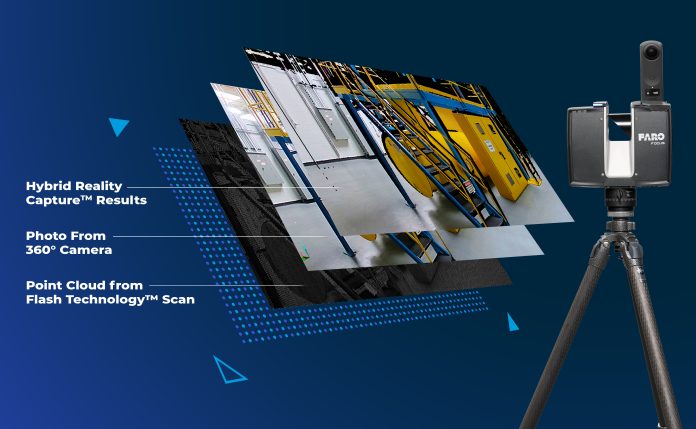Hybrid Reality Capture combines the best qualities of mobile scanning with the best qualities of static reality capture to alter the future of laser scanning
In the last year, discussions concerning artificial intelligence seem to be everywhere. Amazingly, modern AI is now fast enough and accurate enough (though still far from perfect) to approximate natural conversation with both speed and accuracy that mimics human-like exchanges.
This same balancing act between speed and accuracy, known as the speed-accuracy trade-off (SAT), plays itself out in 3D laser scanning and its related offshoots like panoramic 360° photography and photogrammetry.
In traditional 3D reality capture, high-accuracy scans can take minutes to capture and much longer than that to process the information and register the point clouds. For any company looking to complete large-volume scans, this can mean a potential loss of business. A panoramic camera, however, can capture an image with great speed, but the data is less detailed than a 3D point cloud.
Laser scanning can simplify tasks and streamline workflows
Today, those in the business of as-built documentation are continually looking for faster, better, easier ways to get the job done. They are looking to simplify tasks and streamline workflows – without sacrificing quality for speed and speed for quality.
They make this effort because the entire professional measurement services industry has a lot of work on its hands. And lots of time, money and human and technological resources are at stake if BIM models aren’t accurate or if image capture and processing speeds are too sluggish.
Across the globe, the industry is scanning the interior and exterior of large structures; they are mapping and measuring industrial facilities like power plants, they are assisting police and law enforcement with their pre-incident planning, they are aiding speciality and general contractors in their engineering projects, and they are empowering facility managers/owners with the real-time facility management insights they need to track building operations and to eliminate any inefficiencies they uncover.
As might be anticipated, the quest to resolve the speed-accuracy trade-off ultimately took two paths: mobile scanning products and static scanning tripod-mounted 3D laser scanners.
But instead of ending the SAT trade-off, all the development did was carve out two spheres of influence. Repeated studies like one conducted by the University of Cambridge – which included a FARO Focus Laser Scanner – and shared at the 2021 European Conferenceon Computing in Construction, confirms thatmobile scanning, while fast, is not as accurateas a static scan.
Hybrid computing 2.0
If humans and computers were what counted as “hybrid” in the 1960s at NASA (human “computers” were hired to crunch critical launch and re-entry data in part because the space agency’s mainframe wasn’t as accurate as their genius) for 3D reality capture hybrid is about to mean a union of two types of digital formats, uniting the best qualities of mobile scanning with the best qualities of static reality capture.
This union will be in the form of a new technology FARO called Hybrid Reality Capture™, powered by Flash Technology™, released recently. With Flash Technology, an algorithmic merging of the data contained in a panoramic image combined with a 3D point cloud, a lower resolution 3D laser scan is augmented with data captured from a 360° camera, resulting in up to 50% faster scanning than traditional laser scanning workflows.
The benefits of Hybrid Reality Capture should be clear:
- A scan that is designed to be significantly faster than traditional scans.
- 360° images that augment less dense data sets to ensure project completion with accelerated workflows.
- The saving of entire days per week, enabling the taking of additional scans that would likely not have been taken without the added speed and time savings.
- Colourised images allow users to see object edges and corners more clearly and identify defined geometries with greater ease, leading to better analysis and execution in other software.
“Today, those in the business of as-built documentation are continually looking for faster, better, easier ways to get the job done.”
A reality capture solution that’s up to 50% faster than traditional scanning with virtually no loss in data quality means that industries reliant on large-scale scanning, from architecture, engineering, construction and operations and maintenance to public safety, will now have a fast, accurate and reliable way to take thousands of scans and use that data to drive business or situational results, like the fast scanning of entrance and egress points to a large building or the location of obstacles for access.
Considering that there are approximately 100bn buildings in the world and that a sizeable percentage of them includes large-scale construction, the opportunity to accelerate the conversion of the physical world into the digital world, has never been greater.
Hybrid reality capture breaks through the 3D laser scanning industry
Whether it’s the physical frontier or the computational/digital frontier, what has been true since the first cities emerged remains true today. As long as humans populate this world, large, complex structures will be built, requiring fast, accurate assembly and long-term project oversight. For public safety, the need to mitigate worst-case scenarios before they occur will be ever-present.
Hybrid reality capture is the breakthrough the 3D laser scanning industry has been eager to achieve for decades. Now, as AI goes mainstream, soon impacting industries in ways we can only begin to fathom, solving the speed-accuracy trade-off is at least one victory humans can claim as their own.
*Please note: This is a commercial profile.
Amanda Hidalgo
Office of Corporate Communications
FARO Technologies
Tel: +1 700-161-1036

















